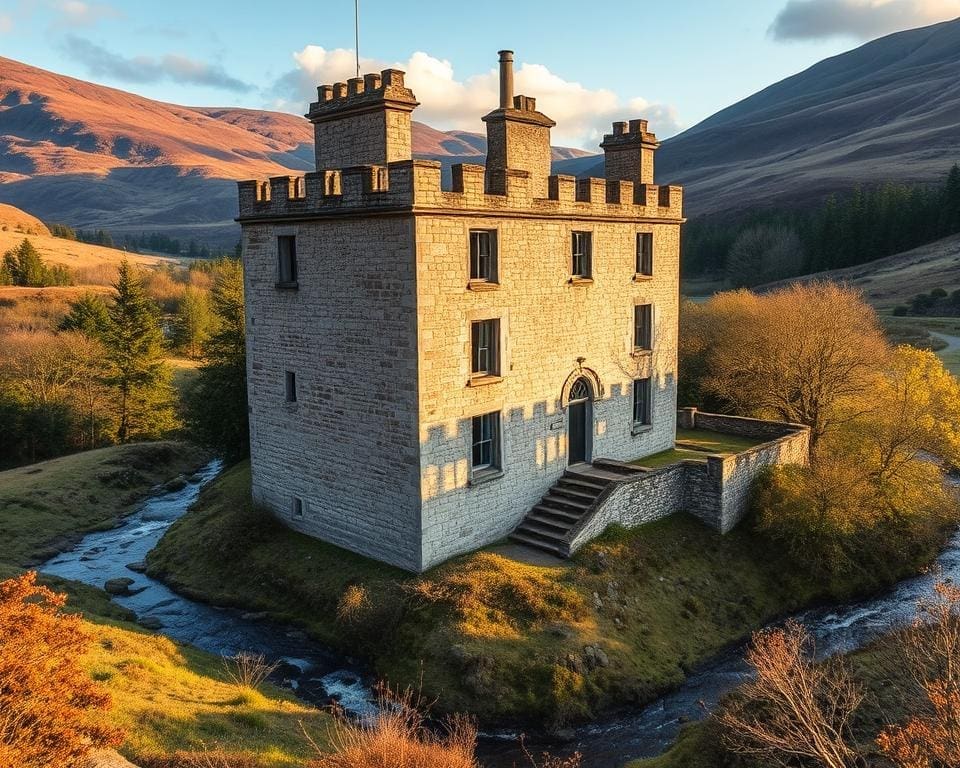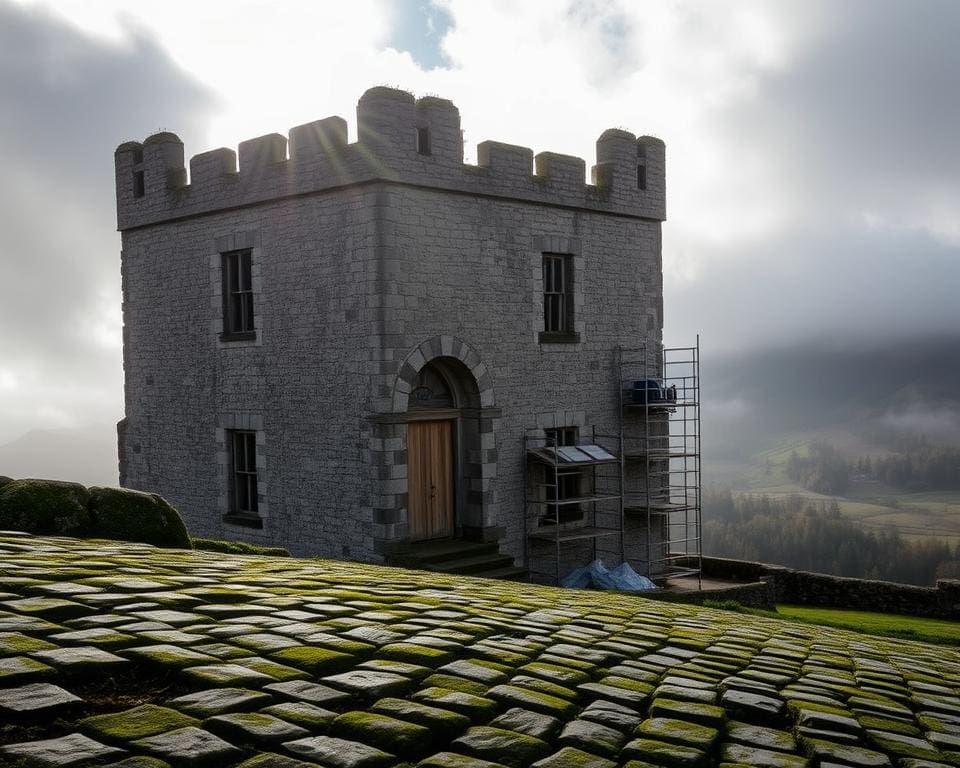Restoring a tower house in the Highlands is a captivating journey that merges history with architectural beauty. These remarkable structures are not only significant to Scotland’s rich cultural narrative but also present unique challenges that make the process both rewarding and complex. Understanding what’s needed to restore a tower house in the Highlands requires an appreciation for the nuances of Scottish castle rehabilitation, where preservation meets modernisation. Each restoration project is an opportunity to breathe new life into these iconic buildings while honouring their storied past.
Understanding the Basics of Tower House Restoration
The process of tower house restoration involves more than mere structural improvements. It requires a deep respect for traditional architecture conservation, ensuring that the unique character of these historic buildings is preserved for future generations. Each tower house tells a story, a narrative woven into its stones and timber.
Fundamental principles guide any successful project in historic building refurbishment. Meticulous planning, thorough assessment, and strategic budgeting form the foundation of effective restoration. A comprehensive understanding of the original architectural styles is essential. This knowledge allows for informed decisions that honour the integrity of the structure while integrating modern conveniences.
In the realm of tower house restoration, it is vital to engage with skilled artisans and conservation specialists. Their expertise ensures that materials used for repairs or replacements match the original as closely as possible, fostering an authentic connection to the past. By blending age-old craftsmanship with contemporary techniques, restorers can revitalise these historical gems while remaining true to their essence.

Ultimately, successful tower house restoration celebrates heritage. It nurtures the stories that historical buildings embodies, fostering a sense of pride and community identity. Each step in the process reinforces the principles of traditional architecture conservation, creating a legacy that resonates with both history enthusiasts and future occupants.
What’s needed to restore a tower house in the Highlands?
Embarking on the journey of restoring a tower house in the Highlands demands a meticulous approach. The initial step involves assessing the current condition of the property. Understanding what is required ensures that restoration aligns with Highlands renovation requirements while preserving the unique character of these remarkable structures.
Assessing the Current Condition
A thorough evaluation of the tower house’s present state forms the foundation of any successful restoration project. Key components to focus on include:
- Structural Integrity: Check for any signs of deterioration that may require immediate attention. Cracks in walls or sagging floors often indicate structural repairs tower house are necessary.
- Material Condition: Identify the quality of original materials such as stone, wood, and roofing. Ensuring these can be retained or appropriately restored is essential.
- Moisture Levels: Assess the presence of dampness or water damage. Managing moisture effectively can safeguard against further decay and is critical in meeting Highlands renovation requirements.
Identifying Key Features of the Structure
One of the most enjoyable aspects of restoration is recognising the distinctive features that give a tower house its charm. Essential elements to observe include:
- Original Windows and Doors: These often showcase craftsmanship that is central to the building’s character.
- Fireplaces and Hearths: Retaining the original fireplace can enhance the authenticity of the home.
- Exterior Details: Elements such as stone carvings or unique roofing styles should be meticulously noted and preserved.
Recognising these features not only aids in crafting an accurate restoration plan but ensures that the rich history of the tower house is honoured throughout the process.
Historical Context and Significance
The tower houses of the Scottish Highlands represent not only distinct architectural forms but also encapsulate a rich historical context that defines their significance. These structures stand as testaments to Scotland’s tumultuous past, reflecting both the regional variations and the broader movements within Scottish architectural heritage. Understanding their evolution gives insight into the social and political dynamics that prevailed during various periods in history.
The Importance of Traditional Architecture Conservation
Preserving these tower houses is essential for maintaining the integrity of Scotland’s cultural identity. Traditional architecture conservation ensures that the unique craftsmanship and design elements inherent in these buildings are not lost to time. Notable features such as rounded turrets, thick stone walls, and ornate mouldings each tell a story that contributes to the broader narrative of Scottish history, fostering a sense of pride and belonging within communities.
Exploring Scotland’s Architectural Heritage
Scotland’s architectural heritage is diverse and captivating. The distinctive characteristics of Highland tower houses reflect a blend of functionality and artistry. Their design evolved in response to both the harsh Highland climate and the social needs of their inhabitants. Embracing traditional architecture conservation allows future generations to appreciate these invaluable structures, ensuring that they continue to inspire admiration and wonder.
Planning Your Restoration Project
Embarking on a tower house restoration in the Highlands requires careful planning and strategic execution. A well-defined approach ensures the project progresses smoothly and meets both aesthetic and functional needs. As part of this process, creating a comprehensive restoration plan is essential while securing the necessary permits will protect against potential setbacks.
Creating a Comprehensive Restoration Plan
Establishing a robust restoration plan forms the backbone of successful project execution. Begin by outlining clear goals and objectives, ensuring they align with the historical significance of the structure. Consider the following components when formulating your plan:
- Timeframe: Set realistic deadlines for each phase of the restoration.
- Tasks: Divide the project into manageable tasks, assigning responsibility for each.
- Resource Allocation: Identify the materials, tools, and workforce needed for efficient progress.
By having a structured restoration plan, you can navigate the complexities of the project with confidence, keeping the vision of the tower house at the forefront.
Obtaining Necessary Permits and Permissions
Navigating the landscape of necessary permits stands as a crucial step in planning restoration efforts. Compliance with local regulations will not only ensure the legality of your work but also honour the structure’s heritage. Begin by consulting with local authorities to understand the specific permits needed for a heritage restoration project.
These may include:
- Listed Building Consent: Required for any alterations to a designated building.
- Planning Permission: Necessary for significant changes to the property.
- Environmental Permits: Relevant if alterations impact surrounding nature.
Securing these necessary permits encourages respect for the historical character of the tower house while contributing to the overall success of the restoration project.
Structural Repairs for Tower Houses
Restoring a tower house often involves addressing various challenges that can compromise the integrity of the structure. Understanding these common structural issues is crucial for ensuring a successful revitalisation of such historic buildings. Experienced restoration projects frequently uncover problems related to damp, subsidence, and material degradation, all of which need prompt attention from qualified professionals.
Identifying Common Structural Issues
When engaging in structural repairs for tower houses, it is essential to identify the prevalent issues that arise during the life of these unique constructions, including:
- Damp – Water intrusion can lead to mould growth and compromise the structural elements.
- Subsidence – Various factors, such as soil movement, can cause uneven settling of the foundations.
- Material Degradation – Age and weathering can deteriorate stone, timber, and other materials critical to the building’s stability.
Engaging Skilled Craftspersons for Repairs
When facing the task of conducting structural repairs, it becomes paramount to engage skilled craftspersons proficient in traditional techniques. Restorators must appreciate the historical significance of the tower house and employ methods that respect its craftsmanship. Working with artisans who specialise in conservation ensures that the repairs maintain the authenticity of the building while adhering to safety standards.
By understanding common structural issues and collaborating with experienced craftspersons, the path to restoring a tower house in the Highlands becomes clearly defined.
Conservation Guidelines in the Highlands
Restoring heritage structures in the Highlands involves familiarity with essential conservation guidelines. These regulations ensure that historical integrity is preserved, maintaining the unique character of buildings while promoting sustainable practices.
Understanding Local Regulations and Compliances
Local regulations play a crucial role in any restoration project. The Highland Council provides specific requirements that govern conservation efforts, which need to be understood in detail. Adhering to these local regulations safeguards both the structure and the surrounding environment. Restoration practitioners must be diligent in obtaining necessary permissions, undertaking risks without prior consultation could lead to significant penalties.
Implementing Best Practices for Heritage Renovation
Adhering to heritage renovation best practices is paramount for a successful restoration. Employing traditional materials and techniques aligns well with the conservation guidelines Highlands stipulate. Focusing on sustainable methods not only benefits the building’s longevity but also plays an important role in conserving the local ecosystem. Engaging qualified professionals with experience in historic buildings can ensure that all efforts comply with existing regulations, thus enhancing the project’s overall success and contributing to the preservation of a treasured past.
Financial Aspects of Restoration
Embarking on a tower house restoration journey involves careful consideration of various financial aspects restoration. Understanding the costs involved is essential for a successful project. Adequate budgeting renovation plays a key role in ensuring that this ambitious venture remains within reach and leads to the desired outcomes.
Budgeting for Your Renovation Project
Effective budgeting is crucial at every stage of the restoration process. Begin by evaluating all anticipated expenses, which may include structural repairs, materials, and labour costs. Creating a detailed budget allows you to allocate funds efficiently and ensures that resources are available when required. Consider potential contingencies, as unexpected challenges often arise during restoration projects. Keeping a flexible budget can help accommodate these uncertainties.
Available Heritage Renovation Grants
Numerous heritage renovation grants exist to support individuals undertaking restoration projects. Researching and applying for these funds can significantly alleviate financial burdens. Grants often focus on preserving historical elements, promoting sustainable practices, and ensuring compliance with local regulations. Engaging with local heritage organisations and financial advisors can help identify relevant grants available in your area.
Embracing Sustainable Practices in Restoration
In the journey of restoring tower houses in the Highlands, integrating sustainable restoration practices is not just a choice but a necessity. This approach champions the dual goals of preserving historical integrity while fostering environmental responsibility. By employing eco-friendly restoration methods, restorers can minimise the carbon footprint associated with renovation, aligning their efforts with contemporary ecological standards.
Enhancing energy efficiency in restoration is key to creating dwellings that are both comfortable and environmentally friendly. Considerations such as installing advanced insulation, utilising energy-efficient windows, and implementing renewable energy sources can significantly reduce energy consumption without compromising aesthetics. These methods not only honour the essence of the tower house but also pave the way for stylish, modern living.
Moreover, the use of in-situ resources promotes a sense of authenticity while reducing waste. By sourcing materials from local suppliers and reusing existing building elements whenever possible, restorers can maintain the tower house’s original charm and character. This progressive mindset inspires future generations to appreciate the unique blend of heritage and sustainability that defines Scotland’s architectural legacy.









